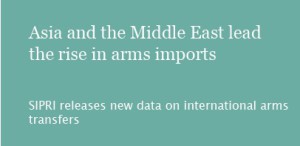DISARMAMENT & SECURITY .
A press release by the Stockholm International Peace Research Institute (SIPRI)
The volume of international transfers of major weapons has grown continuously since 2004 and rose by 14 per cent between 2006–10 and 2011–15, according to new data on international arms transfers published today (22 February 2016) by the Stockholm International Peace Research Institute (SIPRI).

Six of the top 10 largest arms importers in the 5-year period 2011–15 are in Asia and Oceania: India (14 per cent of global arms imports), China (4.7 per cent), Australia (3.6 per cent), Pakistan (3.3 per cent), Viet Nam (2.9 per cent) and South Korea (2.6 per cent). Viet Nam’s arms imports rose by 699 per cent. Arms imports by states in Asia and Oceania increased by 26 per cent between 2006–10 and 2011–15, with states in the region receiving 46 per cent of global imports in 2011–15.
‘China continues to expand its military capabilities with imported and domestically produced weapons,’ said Siemon Wezeman, Senior Researcher with the SIPRI Arms and Military Expenditure Programme. ‘Neighbouring states such as India, Viet Nam and Japan are also significantly strengthening their military forces.’
Imports by Middle Eastern states on the increase
Arms imports by states in the Middle East rose by 61 per cent between 2006–10 and 2011–15. In 2011–15 Saudi Arabia was the world’s second largest arms importer, with an increase of 275 per cent compared to 2006–10. In the same period, arms imports by the United Arab Emirates rose by 35 per cent and those by Qatar went up by 279 per cent. Egypt’s arms imports increased by 37 per cent between 2006–10 and 2011–15, primarily due to a steep rise in 2015.
‘A coalition of Arab states is putting mainly US- and European-sourced advanced arms into use in Yemen,’ said Pieter Wezeman, Senior Researcher with the SIPRI Arms and Military Expenditure Programme. ‘Despite low oil prices, large deliveries of arms to the Middle East are scheduled to continue as part of contracts signed in the past five years.’
Arms exporters: the USA remains well ahead
With a 33 per cent share of total arms exports, the USA was the top arms exporter in 2011–15. Its exports of major weapons increased by 27 per cent compared to 2006–10.
(Article continued on the right column)
(Click here for a version of this article in French or here for a version in Spanish.)
Does military spending lead to economic decline and collapse?
(Article continued from the left column)
Russian exports of major weapons increased by 28 per cent between 2006–10 and 2011–15, and Russia accounted for 25 per cent of global exports in the recent 5-year period. However, in 2014 and 2015 Russian exports returned to the lower annual levels observed in 2006–10.
Chinese exports of major arms were just above those of France in 2011–15, growing by 88 per cent compared to 2006–10. French exports decreased by 9.8 per cent and German exports halved over the same period.
‘As regional conflicts and tensions continue to mount, the USA remains the leading global arms supplier by a significant margin,’ said Dr Aude Fleurant, Director of the SIPRI Arms and Military Expenditure Programme. ‘The USA has sold or donated major arms to at least 96 states in the past five years, and the US arms industry has large outstanding export orders, including for a total of 611 F-35 combat aircraft to 9 states.’
Other notable developments
Between 2006–10 and 2011–15 imports by states in Africa increased by 19 per cent. Algeria and Morocco remained the two largest arms importers in the region with a combined total of 56 per cent of African imports.
Due to economic constraints most sub-Saharan African states imported only small volumes of arms in 2011–15, despite many being involved in armed conflicts during that period.
Mexico’s arms imports grew by 331 per cent in 2011–15 compared with 2006–10.
Azerbaijan increased its arms imports by 217 per cent between 2006–10 and 2011–15.
Arms imports by Iraq rose by 83 per cent between 2006–10 and 2011–15.
France concluded several major arms export contracts in 2015, including the first two firm contracts for its Rafale combat aircraft.
Imports by states in Europe decreased by 41 per cent between 2006–10 and 2011–15.